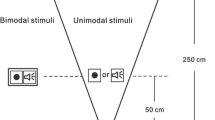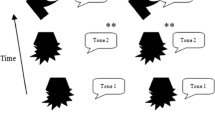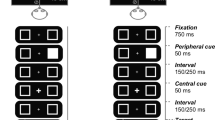Abstract
The Colavita visual dominance effect refers to the phenomenon whereby participants presented with unimodal auditory, unimodal visual, or bimodal audiovisual stimuli in a speeded discrimination task, fail to respond to the auditory component of bimodal targets significantly more often than they fail to respond to the visual component. The Colavita effect was demonstrated in this study when participants were presented with unimodal auditory, unimodal visual, or bimodal stimuli (in the ratios 40:40:20, Experiment 1; or 33:33:33, Experiment 2), to which they had to respond by pressing an auditory response key, a visual response key, or both response keys. The Colavita effect was also demonstrated when participants had to respond to the bimodal targets using a dedicated third (bimodal) response key (Experiment 3). These results therefore suggest that stimulus probability and the response demands of the task do not contribute significantly to the Colavita effect. In Experiment 4, we investigated what role exogenous attention toward a sensory modality plays in the Colavita effect. A significantly larger Colavita effect was observed when a visual cue preceded the bimodal target than when an auditory cue preceded it. This result suggests that the Colavita visual dominance effect can be partially explained in terms of the greater exogenous attention-capturing qualities of visual versus auditory stimuli.

Similar content being viewed by others
Notes
Colavita and his colleagues (Colavita 1974; Colavita et al. 1976; Colavita and Weisberg 1979) defined the ‘prepotency of the visual over the auditory stimulus’ in terms of the fact that participants made more light-key than tone-key responses on the bimodal trials. In contrast, Egeth and Sager (1977) defined visual dominance in terms of the slowing of reaction times (RTs) to an auditory stimulus which they attributed to the presence of a concurrent visual stimulus. Subsequent research has, however, most frequently reverted to Colavita’s original definition (e.g., Koppen and Spence in press, submitted a, b; Sinnett et al. in press).
It should be noted that the task that participants had to perform could also be considered to be a modality detection task. Quite what is the most appropriate description for the task is ambiguous, as participants were both detecting stimuli in different modalities, and discriminating which modality a target had been presented in.
It is interesting to note that participants in our experiments responded more rapidly to unimodal than to bimodal targets, which is the reverse pattern of response latencies observed in redundant target paradigms (Miller 1982). The main difference between the Colavita effect and redundant target paradigm lies in the response requirements of the tasks: in the former, participants make modality discriminations, whereas in the latter they tend to make simple detection responses instead.
We re-ran the analysis on the arcsine-transformed error data to ensure normality and homogeneity of variance. This analysis produced the same results. There was a significant main effect of Target Stimulus (Auditory, Bimodal, or Visual) [F(1.09, 14.20) = 21.16, P < 0.001], due to participants responding less accurately on bimodal target trials (P = 0.39; where P is the arcsine-transformed proportion) than on either unimodal auditory (P = 0.19; t(13) = 5.60, P < 0.001) or unimodal visual target trials (P = 0.19; t(13) = 4.14, P = 0.001), but no less accurately on unimodal visual than on unimodal auditory target trials (t(13) = 0.67, P = 0.515).
Note that we did not attempt to match the intensity of the auditory and visual stimuli in the present study (cf. Spence et al. 2001b), which means that the visual stimuli used in our studies might have been subjectively less intense or alerting than the auditory stimuli. However, in this regard it should be noted that Colavita (1974, Experiment 2) attempted to make the auditory stimuli twice as intense as the visual stimulus, but found that the magnitude of the Colavita effect was unaffected by the experimental manipulation of relative subjective target intensity.
References
Bertelson P (1961) Sequential redundancy and speed in a serial two-choice responding task. Q J Exp Psychol 13:90–102
Bertelson P, Aschersleben G (1998) Automatic visual bias of perceived auditory location. Psychon Bull Rev 5:482–489
Bertelson P, de Gelder B (2004) The psychology of multimodal perception. In: Spence C, Driver J (eds) Crossmodal space and crossmodal attention. Oxford University Press, Oxford, pp 141–177
Boulter LR (1977) Attention and reaction times to signals of uncertain modality. J Exp Psychol Human Percept Perform 3:379–388
Campbell KC, Proctor RW (1993) Repetition effects with categorizable stimulus and response sets. J Exp Psychol Learn Mem Cogn 19:1345–1362
Colavita FB (1974) Human sensory dominance. Percept Psychophys 16:409–412
Colavita FB, Tomko R, Weisberg D (1976) Visual prepotency and eye orientation. Bull Psychon Soc 8:25–26
Colavita FB, Weisberg D (1979) A further investigation of visual dominance. Percept Psychophys 25:345–347
Driver J, Spence C (2000) Multisensory perception: beyond modularity and convergence. Curr Biol 10:R731–R735
Egeth HE, Sager LC (1977) On the locus of visual dominance. Percept Psychophys 22:77–86
Ernst MO, Banks MS (2002) Humans integrate visual and haptic information in a statistically optimal fashion. Nature 415:429–433
Fagot C, Pashler H (1992) Making two responses to a single object: implications for the central attentional bottleneck. J Exp Psychol Hum Percept Perform 18:1058–1079
Giard MH, Peronnet F (1999) Auditory-visual integration during multimodal object recognition in humans: a behavioral and electrophysiological study. J Cog Neurosci 11:473–490
Hamlin AJ (1895) On the least observable interval between stimuli addressed to disparate senses and to different organs of the same sense. Am J Psychol 6:564–575
Harvey N (1980) Non-informative effects of stimuli functioning as cues. Q J Exp Psychol 32:413–425
Hay JC, Pick HLJ, Ikeda K (1965) Visual capture produced by prism spectacles. Psychonom Sci 2:215–216
Heron J, Whitaker D, McGraw PV (2004) Sensory uncertainty governs the extent of audio-visual interaction. Vis Res 44:2875–2884
Holender D (1980) Interference between a vocal and a manual response to the same stimulus. In: Stelmach GE, Requin J (eds) Tutorials in motor behaviour. North-Holland, Amsterdam, pp 421–431
Howard IP, Templeton WB (1966) Human spatial orientation. Wiley, New York
Johnson TL, Shapiro KL (1989) Attention to auditory and peripheral visual stimuli: effects of arousal and predictability. Acta Psychol 72:233–245
Klein RM (1977). Attention and visual dominance: a chronometric analysis. J Exp Psychol Hum Percept Perform 3:365–378
Koppen C, Spence C (in press) Spatial coincidence modulates the Colavita visual dominance effect. Neurosci Lett
Koppen C, Spence C (submitted a) Assessing the endogenous attentional account of the Colavita visual dominance effect. Manuscript submitted for publication
Koppen C, Spence C (submitted b) Semantic congruency and the Colavita effect. Manuscript submitted for publication
Kornblum S (1973) Sequential effects in choice reaction time: a tutorial review. In: Kornblum S (ed) Attention and performance, vol 4. Academic Press, New York, pp 259–288
Laurienti PJ, Kraft RA, Maldjian JA, Burdette JH, Wallace MT (2004) Semantic congruence is a critical factor in multisensory behavioral performance. Exp Brain Res 158:405–414
McGurk H, MacDonald J (1976) Hearing lips and seeing voices. Nature 264:746–748
Miller JO (1982) Divided attention: evidence for coactivation with redundant signals. Cogn Psychol 14:247–279
Molholm S, Ritter W, Murray MM, Javitt DC, Schroeder CE, Foxe JJ (2002) Multisensory auditory-visual interactions during early sensory processing in humans: a high-density electrical mapping study. Cogn Brain Res 14:121–134
Moore JJ, Massaro DW (1973) Attention and processing capacity in auditory recognition. J Exp Psychol 99:49–54
Morein-Zamir S, Soto-Faraco S, Kingstone A (2003) Auditory capture of vision: Examining temporal ventriloquism. Cogn Brain Res 17:154–163
Nickerson R (1973) Intersensory facilitation of reaction time: Energy summation or preparation enhancement? Psychol Rev 80:489–509
Partan S, Marler P (1999) Communication goes multimodal. Science 283:1272–1273
Pashler H (1998) The psychology of attention. MIT, Cambridge
Pashler H, Baylis G (1991) Procedural learning: 2. Intertrial repetition effects in speeded-choice tasks. J Exp Psychol Learn Mem Cogn 17:33–48
Posner MI (1978) Chronometric explorations of mind. Erlbaum, Hillsdale
Posner MI, Nissen MJ, Klein RM (1976) Visual dominance: an information-processing account of its origins and significance. Psychol Rev 83:157–171
Posner MI, Nissen MJ, Ogden WC (1978) Attended and unattended processing modes: the role of set for spatial location. In: Pick HI, Saltzman IJ (eds) Modes of perceiving and processing information. Erlbaum, Hillsdale, pp 137–157
Quinlan P (2000) The ‘late’ locus of visual dominance. Abstr Psychon Soc 5:64
Randich A, Klein RM, LoLordo VM (1978) Visual dominance in the pigeon. J Exp Anal Behav 30:129–137
Recanzone GH (2003) Auditory influences on visual temporal rate perception. J Neurophysiol 89:1078–1093
Rock I, Harris CS (1967, 17 May). Vision and touch. Sci Am 216:96–104
Rock I, Victor J (1964) Vision and touch: an experimentally created conflict between the two senses. Science 143:594–596
Rodway P (2005) The modality shift effect and the effectiveness of warning signals in different modalities. Acta Psychol 120:199–226
Sanders AF (1975) The foreperiod effect revisited. Q J Exp Psychol 27:591–598
Schneider W, Eschman A, Zuccolotto A (2002a) E-Prime user’s guide. Pittsburgh Psychology Software Tools Inc.
Schneider W, Eschman A, Zuccolotto A (2002b) E-Prime reference guide. Pittsburgh Psychology Software Tools Inc.
Shams L, Kamitani Y, Shimojo S (2000) What you see is what you hear: Sound induced visual flashing. Nature 408:788
Shapiro KL, Egerman B, Klein RM (1984) Effects of arousal on human visual dominance. Percept Psychophys 35:547–552
Shapiro KL, Jacobs WJ, LoLordo VM (1980) Stimulus-reinforcer interactions in Pavlovian conditioning of pigeons: implications for selective associations. Anim Learn Behav 8:586–594
Shimojo S, Shams L (2001) Sensory modalities are not separate modalities: plasticity and interactions. Curr Opin Neurobiol 11:505–509
Sinnett S, Spence C, Soto-Faraco S (in press) Visual dominance and attention: the Colavita effect revisited. Percept Psychophys
Smith WF (1933) The relative quickness of visual and auditory perception. J Exp Psychol 16:239–257
Soetens E (1998) Localizing sequential effects in serial choice reaction time with the information reduction procedure. J Exp Psychol Human Percept Perform 10:581–598
Soetens E, Melis A, Notebaert W (2002) Sequence learning and sequential effects. Psychol Res 69:124–137
Spence C, Driver J (1997) Audiovisual links in exogenous covert spatial orienting. Percept Psychophys 59:1–22
Spence C, Nicholls MER, Driver J (2001a) The cost of expecting events in the wrong sensory modality. Percept Psychophys 63:330–336
Spence C, Shore DI, Klein RM (2001b) Multisensory prior entry. J Exp Psychol Gen 130:799–832
Titchener EB (1908) Lectures on the elementary psychology of feeling and attention. Macmillan, New York
Turatto M, Benso F, Galfano G, Gamberini L, Umiltà C (2002) Non-spatial attentional shifts between audition and vision. J Exp Psychol Hum Percept Perform 28:628–639
Turatto M, Galfano G, Bridgeman B, Umiltà C (2004) Space-independent modality-driven attentional capture in auditory, tactile and visual systems. Exp Brain Res 155:301–310
Watanabe K, Shimojo S (1998) Attentional modulation in perception of visual motion events. Perception 27:1041–1054
Welch RB, DuttonHurt LD, Warren DH (1986) Contributions of audition and vision to temporal rate perception. Percept Psychophys 39:294–300
Welch RB, Warren DH (1986) Intersensory interactions. In Boff KR, Kaufman L, Thomas JP (eds) Handbook of perception and performance: vol 1. Sensory processes and perception, Wiley, New York, pp 25-1–25-36
Zampini M, Shore DI, Spence C (2005) Audiovisual prior entry. Neurosci Lett 381:217–222
Acknowledgments
C. K. was supported by a Departmental Studentship from the Department of Experimental Psychology, University of Oxford.
Author information
Authors and Affiliations
Corresponding author
Rights and permissions
About this article
Cite this article
Koppen, C., Spence, C. Seeing the light: exploring the Colavita visual dominance effect. Exp Brain Res 180, 737–754 (2007). https://doi.org/10.1007/s00221-007-0894-3
Received:
Accepted:
Published:
Issue Date:
DOI: https://doi.org/10.1007/s00221-007-0894-3




